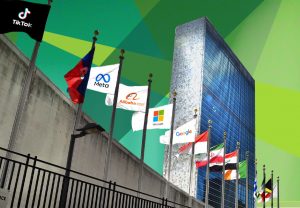By Lazaros Siantsis
 In the study of International Relations, the distribution of power among global actors is of crucial importance to understanding both historical patterns of conflict and cooperation, as well as mapping future geopolitical dynamics. From the era of unipolar dominance by the United States of America to the complexities of a multipolar international system and the emerging concept of a technopolar world, the balance of power continues to evolve. The paper draws upon the relevant international relations scholarship to schematically present the all these different frameworks—unipolar, bipolar, multipolar, apolar, and technopolar—which represent various constellations of influence that shape and will continue to shape the future global governance, security, and economic arrangements.
In the study of International Relations, the distribution of power among global actors is of crucial importance to understanding both historical patterns of conflict and cooperation, as well as mapping future geopolitical dynamics. From the era of unipolar dominance by the United States of America to the complexities of a multipolar international system and the emerging concept of a technopolar world, the balance of power continues to evolve. The paper draws upon the relevant international relations scholarship to schematically present the all these different frameworks—unipolar, bipolar, multipolar, apolar, and technopolar—which represent various constellations of influence that shape and will continue to shape the future global governance, security, and economic arrangements.
- The Unipolar Moment: A Singular Superpower
Unipolarity became most pronounced after the Cold War, particularly following the collapse of the Soviet Union in 1991. The United States emerged as the sole global hegemon, dominating the military, economic, and cultural arenas. Charles Krauthammer’s concept of the “unipolar moment” highlighted this shift, marking an era of unparalleled American influence (Krauthammer, 1990).
Key Characteristics:
- Global Influence: The hegemon sets global norms, leads international institutions, and often determines the agenda for multilateral cooperation.
- Hegemonic Stability Theory: As argued by scholars like Robert Gilpin, unipolarity can create international stability, as the hegemon possesses both the capacity and incentive to maintain order (Gilpin, 1981).
Examples:
A prominent example is that of the United States after 1991, when its military and economic preeminence was unchallenged. However, challenges arose as rising powers such as China and Russia sought to assert themselves on the global stage, testing the limits of U.S. dominance (Wohlforth, 1999).
Limitations of Unipolarity:
While the U.S. dominance provided a relatively stable global order, it also triggered counterbalancing behavior from other actors. For instance, China’s Belt and Road Initiative and Russia’s resurgence in Europe and the Middle East have challenged the unipolar structure, revealing the potential instability, which is likely inherent in unipolarity.
- The Cold War and Bipolar Stability
During the Cold War (1947-1991), the world was dominated by two superpowers: the United States and the Soviet Union. Kenneth Waltz’s theory of neorealism (or structural realism) suggests that bipolar systems tend to be more stable than multipolar ones due to clear threat identification and alliance structures (Waltz, 1964).
Key Characteristics:
- Clear Spheres of Influence: Each superpower constructed a bloc of aligned states, minimizing the fluidity often seen in multipolar systems.
- Mutual Deterrence: The Cold War’s concept of mutually assured destruction (MAD) prevented direct conflict, as both superpowers had nuclear capabilities sufficient to obliterate each other.
Examples:
A characteristic example is that of the U.S.-Soviet rivalry, with proxy wars in Korea, Vietnam, and Afghanistan, but with no direct military confrontation. While this created a paradox of stability amidst tension, the collapse of the Soviet Union in 1991 resulted in a power vacuum, leading to global rearrangements.
- Multipolarity: A World of Many Powers
The 21st century has seen the emergence of multiple rising powers, including China, India, and the European Union, signaling a potential shift toward a multipolar world. A multipolar system is characterized by several powerful actors that balance one another, each holding significant influence in military, economic, and diplomatic arenas.
Key Characteristics:
- Multiple Centers of Power: No single actor dominates; instead, several states share power, which leads to a more dynamic, but also unpredictable global environment.
- Fluid Alliances: Unlike the fixed blocs of bipolarity seen above, multipolar systems are marked by shifting alliances and partnerships, which can lead to both cooperation and conflict.
Examples:
The pre-World War I era, where Germany, Britain, France, Austria-Hungary, and Russia vied for dominance, illustrates multipolarity. Today, the United States, China, Russia, the EU, and India represent key poles in a potentially multipolar global structure. However, this balance is fragile, with rising tensions, particularly between the U.S. and China, indicating instability (Kupchan, 2012).
Challenges of Multipolarity:
Multipolarity complicates international governance, as global institutions (e.g., the United Nations, World Trade Organization) – which were designed during unipolar or bipolar times – struggle to adapt to this more fragmented structure and reality. This shift creates opportunities for competition and contestation, and power vacuums often arise in regions where no dominant actor enforces order.
- Apolar (Dis)order: A World Without Polarity
Apolar systems lack a dominant power or organized bloc of powers. Instead, power is fragmented, and no single entity has the ability to enforce global norms or manage international conflicts. This could occur as global influence shifts away from nation-states and is dispersed across various non-state actors.
Key Characteristics:
- Fragmented Power: Influence is distributed not just among states but also among non-state actors such as multinational corporations, international organizations, and even non-state armed groups.
- Lack of Global Governance: Without a central authority to enforce norms, global governance becomes fragmented. This in turn might lead to greater regional conflicts and instability.
Examples:
The post-9/11 world, characterized by the rise of non-state actors like terrorist organizations (e.g., al-Qaeda) and cyber warfare, represents elements of apolarity. The inability to manage transnational threats, such as terrorism and climate change further exemplifies the concept of apolar disorder (Ferguson, 2004).
Consequences of Apolarity:
An apolar world would lead to greater unpredictability in international affairs, with the absence of a clear leader (a single state or an alliance of states, or an international organization) making it difficult to address global challenges such as economic inequality, climate change, or security threats.
- The Technopolar World: Power Beyond States
The rise of technology giants—such as Google, Amazon, Facebook, and Tencent—has led to the emergence of a technopolar world, where power is not only distributed among states but also resides with non-state actors controlling critical technological infrastructure, data flows, and digital platforms. These companies are shaping not only global economics but also the political and social spheres. As the renowned political scientist Ian Bremmer famously put it: “It used to be just nature and nurture determining our identities, now its nature, nurture & Algorithms”.
Key Characteristics:
- Data as Power: In a technopolar system, control over data, algorithms, and digital connectivity is as vital as control over territory or natural resources. Technologies like artificial intelligence (AI) and cloud computing are becoming central to global governance, informing at the same time the very nature of conflict.
- Private Sector Governance: Companies like Amazon and Google not only operate vast global supply chains but also control immense volumes of personal and corporate data, often surpassing the influence of numerous nation-states.
Examples:
A prominent example is the Cambridge Analytica scandal, where Facebook’s data was used to influence political elections, underscoring the growing political power in the hands of technology firms. The monopolistic tendencies of major tech companies have raised a series of questions about sovereignty, accountability, and governance, challenging the traditional state-centric model of power (Moore & Tambini, 2018).
Implications of Technopolarity:
The emergence of a technopolar era or ‘new globalization’ raises critical issues about sovereignty, accountability, and the role of multinational corporations in global governance, economic relations and security. As these firms continue to expand their reach, they may begin to shape political outcomes in ways that traditional states are even unable to match.
Conclusion: A Complex Future of Power Configurations
The global distribution of power is no longer defined by a singular, clear-cut structure. From unipolarity to bipolarity, and from multipolarity to the emerging technopolar world, each configuration brings both opportunities and risks. The rise of China, the resurgence of Russia, and the increasing influence of technology corporations indicate that the future of global power will be shaped by a multitude of actors.
This complexity demands a reevaluation of how we approach governance, international relations, and global cooperation. The future will likely see a hybrid system where technological influence and state power are intricately intertwined. For instance, EU’s Artificial Intelligence Act and data protection regulations ought to be understood within this new geopolitical framework, in which a player tries to position itself as a leader in global AI governance and attempts to maintain digital autonomy against tech companies and external powers like the U.S. and China. Scholars, policymakers, and global citizens must adapt to these shifts to navigate the evolving landscape of international relations.
References:
- Bremmer, I. (2021) The Technopolar Moment: How Digital Powers Will Reshape the Global Order, Foreign Affairs. Available at: https://www.foreignaffairs.com/articles/world/ian-bremmer-big-tech-global-order
- Ferguson, N. (2004). A World Without Power. Foreign Policy, (143), 32-39.
- Gilpin, R. (1981). War and Change in World Politics. Princeton University Press.
- Krauthammer, C. (1990). The Unipolar Moment. Foreign Affairs, 70(1), 23-33.
- Kupchan, C. A. (2012). No One’s World: The West, the Rising Rest, and the Coming Global Turn. Oxford University Press.
- Moore, M., & Tambini, D. (Eds.). (2018). Digital Dominance: The Power of Google, Amazon, Facebook, and Apple. Oxford University Press.
- Waltz, K. N. (1964). The Stability of a Bipolar World. Daedalus, 93(3), 881-909.
- Wohlforth, W. C. (1999). The Stability of a Unipolar World. International Security, 24(1), 5-41.

 Αριστοτέλειο Πανεπιστήμιο Θεσσαλονίκης
Αριστοτέλειο Πανεπιστήμιο Θεσσαλονίκης